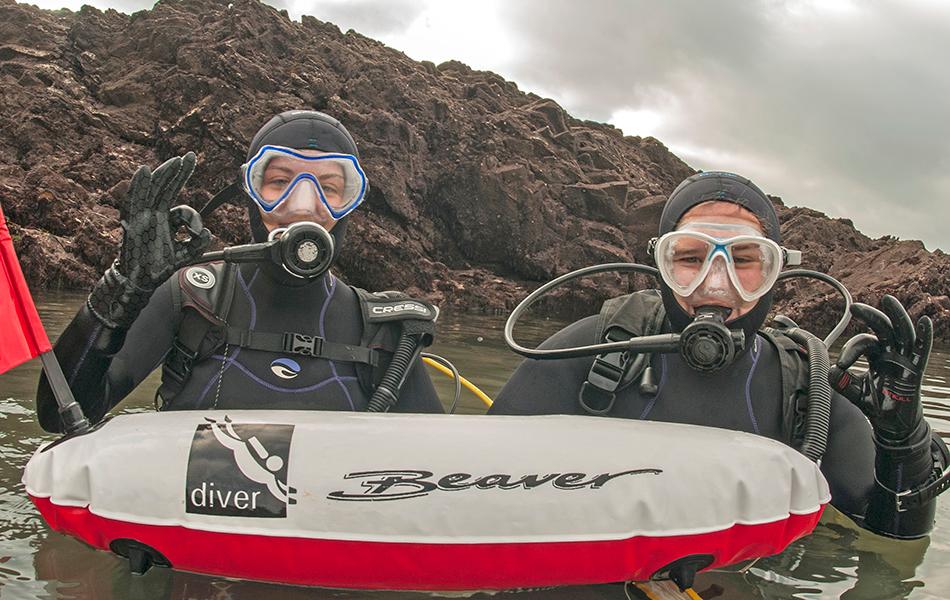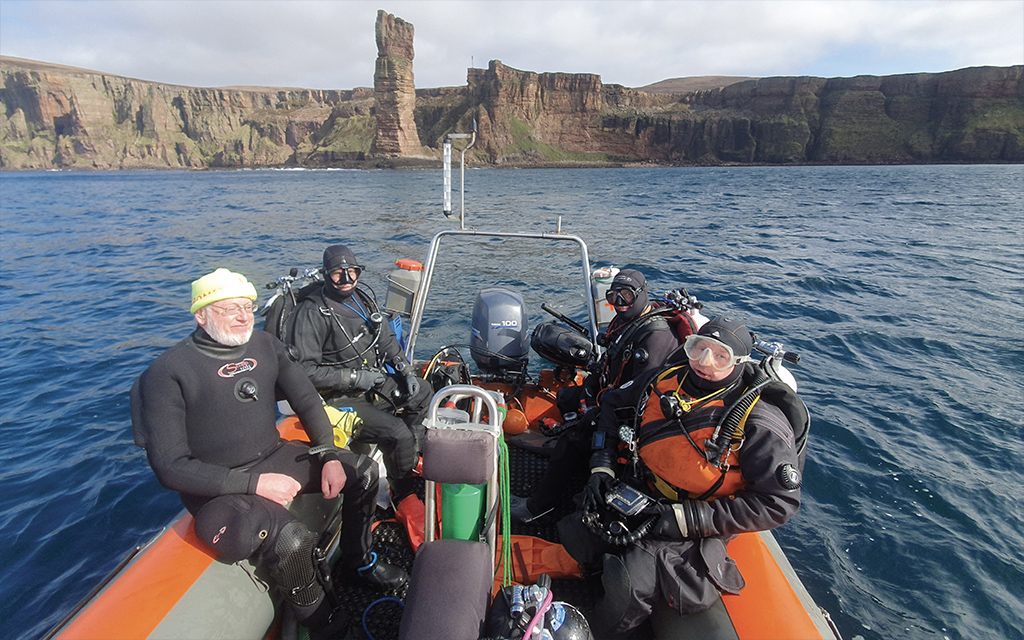
Kristina Pedder meets Orkney Sub-Aqua Club, whose members are ideally located for great diving opportunities.
LOCATION: Orkney Islands, North Scotland
MEMBERSHIP FEE: £95 (+ BSAC)
CONTACT: orkneysubaquaclub@gmail.com | Orkney Sub Aqua Club
More than 500 miles of diverse and dramatic coastline around the Orkney Islands, including exposed Atlantic and North Sea beaches and sheltered bays, provide diving aplenty. There’s long been a local dive community exploring the stunning natural features both above and below the water; let’s hear the story of their club.
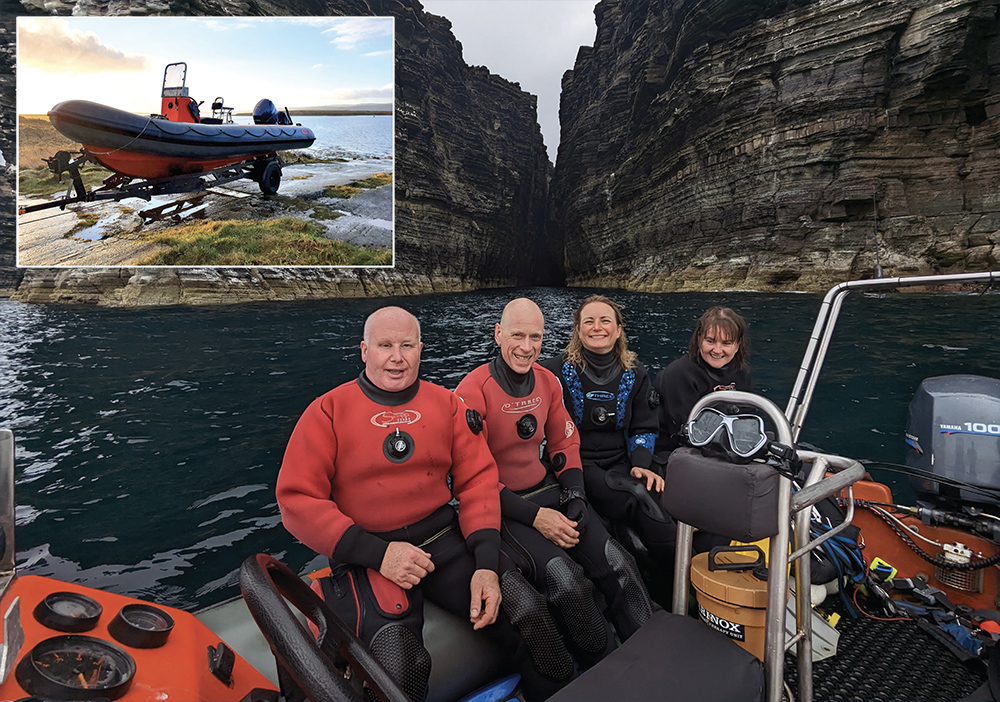
[inset] launching the RIB; [main image] about to dive the geo at Westray
When was Orkney Sub Aqua Club formed?
The original ScotSAC branch was formed in May 1969 in Mainland, Orkney, off the north coast of mainland Scotland and remained with the Scottish national agency for five decades, moving across to BSAC in 2020 to gain easier access to training and club support.
Who are your members?
Our 20 members represent a wide profile of Orkney residents, as well as others who dive with us when they are visiting the islands. At present we have two Ocean Divers, four Sports Divers, seven Dive Leaders and seven Advanced Divers. We aim to grow the club further, by focusing on online visibility and community engagement.
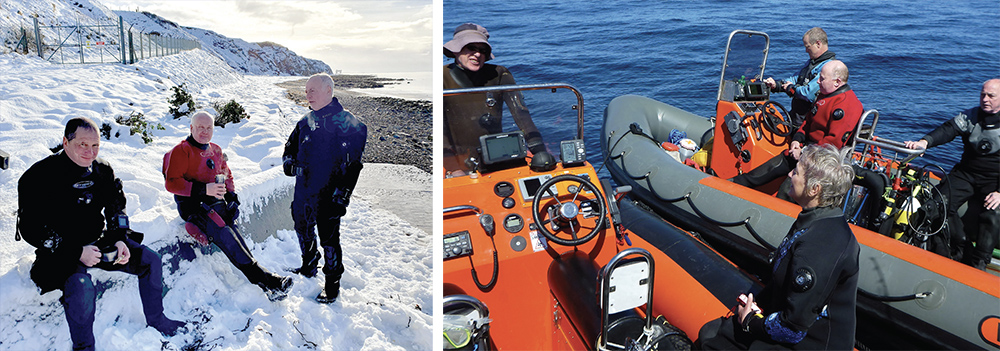
[L] Equipment Officer Lindsay Reid, Chair Lee Spence and Robbie Bruce on a snowy surface interval; [R] A two-RIB dive day
What resources does the club have?
The club runs a 5.8-metre rigid-hulled inflatable boat (RIB), which can comfortably take a maximum of six divers. If we require more space or are planning a longer distance offshore trip, then other club members with personal RIBs take these along as well. We have a small clubhouse in Hatston in Kirkwall where we run training, store our boat and operate our compressor. We own two club cylinders for both trainees and general member use. We also have an oxygen first aid kit.
How does the club raise funds?
Members pay a small boat fee of £15 for a day’s RIB diving. Our club has also been successful in raising some funds through grant applications from local organisations, as well as national charitable initiatives. We have also raised money through our local community charity shop, where various organisations take turns to donate items for sale and staff the shop for a week to raise funds for their projects. Our fundraising has enabled us to carry out necessary repairs to our clubhouse and to replace essential items such as our compressor and oxygen kit.
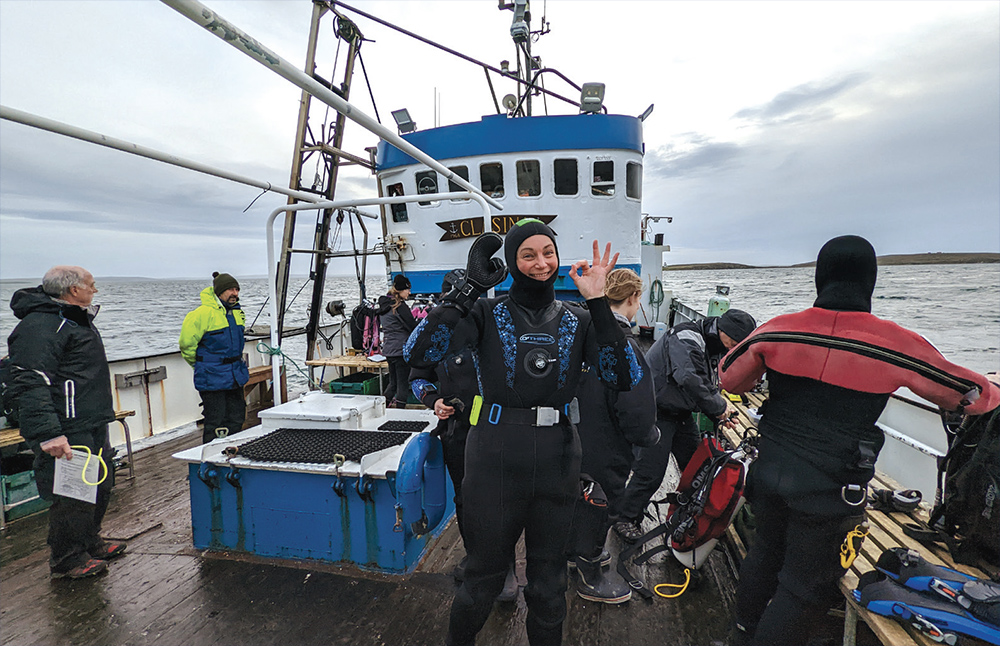
Diving Officer Jenni Kakkonen on the Underwater Surveyor course
Being on an island gives you easy access to diving – how often do you get out?
Members dive most weekends, all year long if the weather allows. We are not restricted by water temperatures (minimum 6°C, max 14°C) but the strong winds and wind chill can be a barrier to diving. Generally, we dive from our club RIB, although we also carry out shore dives on the First and Second World War blockships at the Churchill Barriers. Sometimes we dive from the far more comfortable charter boats that operate out of Stromness.
When we dive from our RIB, we can launch from various slips to dive all around Orkney. You can see a video from a perfect day out in January on our Facebook page. We were out from sunrise to sunset, it was flat calm, we had lunch on Cava Island and the diving was great.
Visiting divers will know the German fleet wrecks in Scapa Flow, but as locals where do you like to dive?
As you say, we have easy access to Scapa Flow and we do dive the German Fleet. We have a tremendous diversity of dive sites around Orkney, including a wealth of scenic dive sites available to us throughout the islands, from beautiful maerl and seagrass beds to stunning wall dives with abundant marine life. We are very lucky to have all this right on our doorstep. We also dive smaller, lesser dived wrecks both in the Flow and elsewhere around the islands.

[L-to-R] Alastair Skene, the club's personal sea life expert; Laura Baker at Scabra Head; Club Secretary Laura Baker on Nevi Skerry, Scapa Flow
Tell us about your favourite sites
One of the best is the geo at Noup Head, at the western tip of Westray in the North Isles. Conditions mean we only make it up there once or maybe twice a year, and it is always something special. This high-energy site is a long, narrow gully, in places only a couple of metres wide, filled with beautiful clear water. It is covered in life. Crawfish have been seen on all our recent dives here, and the gannets and guillemots that nest in the cliffs above are often seen swimming around us chasing their lunch. With a maximum depth of 20 to 25 metres, it’s accessible for many levels of diving qualification.
Another favourite site is Scabra Head, at the West of Rousay; a regular hotspot, particularly in summer. There are huge, flat, well-scoured rock faces – a very impressive sight – and boreholes nearly 10m deep fall away in the smooth rock surfaces. There are plenty of lobsters and brown crabs at the bottom ready to snap at a passing diver.
Our divers have discovered a sea cave section, which supports a large stone lintel stretching across the centre of the cave; a truly amazing feature. On summer evenings the light from the setting sun makes the stone arch shine. The more we dive this location the more caves and gullies we find.
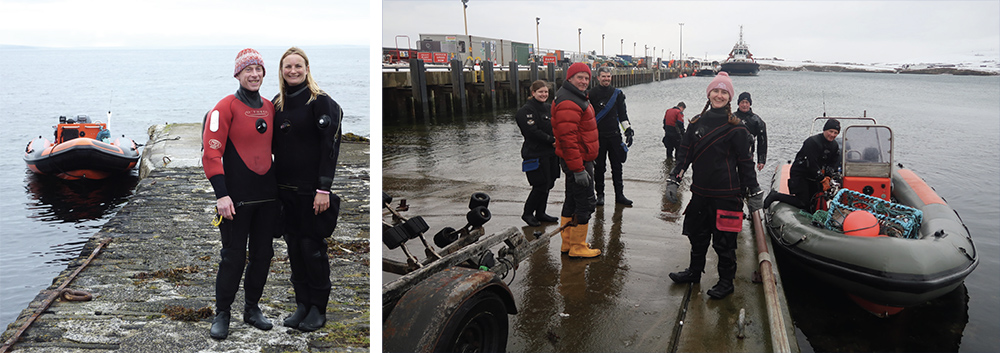
[L] Diving Officer Jenni Kakkonen and Duncan Johnston enjoying a surface interval break; [R] Ghost Fishing UK training
And when you go wreck diving…
Kevin Heath of Lost in Waters Deep, a project to remember the First World War naval losses off mainland Scotland, the Western Isles, Orkney and Shetland (lostinwatersdeep.co.uk) and winner of the BSAC Expeditions Trophy for 2022, is a member of our club and he has given us some exciting suggestions of sites to visit around Orkney to dive some lesser-known marine archaeology.
You sound like an adventurous bunch. Has the club been involved in any special projects?
We have been lucky to have been invited to collaborate on projects including Project Seagrass surveying and Ghost Fishing UK training; we also regularly conduct Seasearch dives. We were invited to get involved with an early version of the BSAC Underwater Surveyor course. The club has made its own Baited Remove Underwater Video (BRUV) setup, using a GoPro camera, which we regularly take with us and deploy around Orkney during dive days. The data collected from this is fed back to Seasearch. So far, we haven’t seen anything particularly notable on our BRUV, but we’re hoping eventually we’ll get lucky and capture some footage of a rare flapper skate.
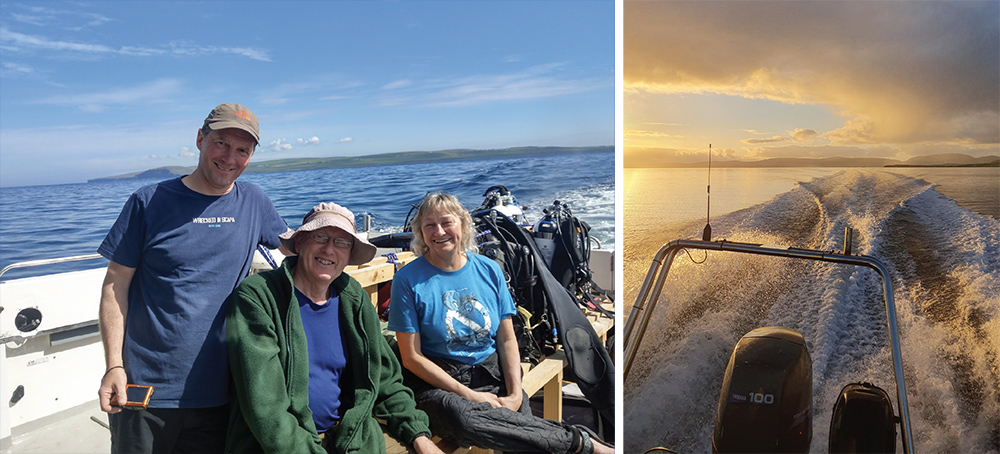
[L] A sunny day on Taurus J - Lindsay Reid, Alastair Skene and Penny Martin; [R] January sunset at 3pm
Does the club offer diver training?
We face a few challenges to deliver training. Practical training is sometimes restricted by changes in the weather, but our main limitation is the number and availability of local instructors. We have one active Open Water Instructor and one Advanced Instructor, but we want to expand. We plan to address our instructor shortage by developing assistant instructors alongside diver training.
How are you coping in the meantime?
Our members have been very lucky to be invited by Aberdeen Sub Aqua Club to join their online diver training and have participated in Ocean Diver through to Advanced Diver sessions, as well as online lectures for Skill Development Courses such as Boat Handling. Other BSAC instructors from across the UK are frequently in Orkney to dive the German Fleet and have generously given their time and expertise to support the progression of diver training for our members. Our club would not have grown to the extent that it has within the past few years without their support.
What is the club most proud of?
Since joining BSAC, our club membership has expanded and club dives now take place most weekends. So much more diving is going on. We have explored many new dive sites around Orkney that were previously either unknown to us or had not been dived since the 1990s. We have built friendships with other clubs both in the UK and across Europe, and with marine charities such as Project Seagrass and Ghost Fishing UK. This has resulted in widening the diversity of dive sites and the dive projects that our members have been involved in.
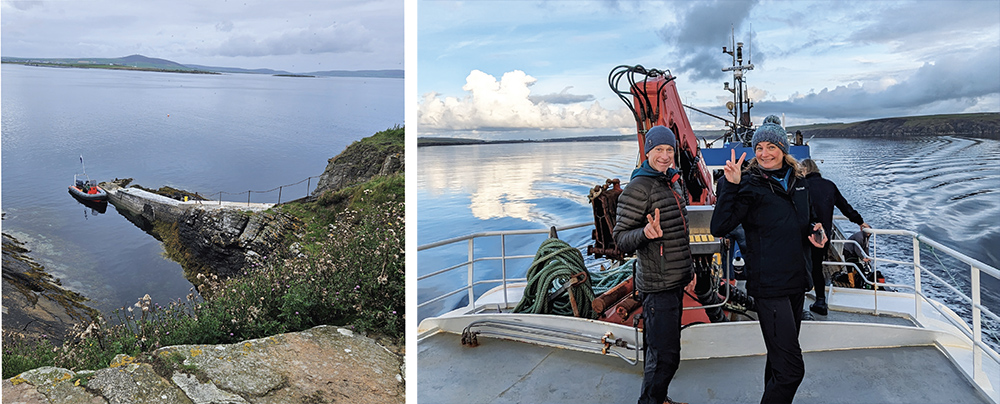
[L] Many dive days include exploring uninhabited islands; [R] Duncan and Jenni celebrate their completion of the Underwater Surveyor course
What is the club planning for the next few years?
We are organising a club trip to Unst in the north of Shetland this summer, to explore some scenic sites new to us, as well as visit some classic wrecks such as the British submarine E49, which hit a mine in 1917 and was lost with all her crew.
As part of the North Scotland BSAC region, we are planning to join forces with other clubs in the region to deliver training courses. We have already started to link up on trips with the view to organise more shared trips in the future. We welcome guests and are happy to answer enquiries from divers interested in our club.
Article ‘Club Focus – Orkney Sub-Aqua Club' by Kristina Pedder first published in SCUBA magazine, Issue 157 July/August 2025.
How do I find scuba diving near me?
If you want to learn to dive in Orkney with Orkney Sub-Aqua Club, please contact orkneysubaquaclub@gmail.com.




